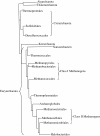Breaking through a phylogenetic impasse: a pair of associated archaea might have played host in the endosymbiotic origin of eukaryotes
- PMID: 22913376
- PMCID: PMC3490757
- DOI: 10.1186/2045-3701-2-29
Breaking through a phylogenetic impasse: a pair of associated archaea might have played host in the endosymbiotic origin of eukaryotes
Abstract
For over a century, the origin of eukaryotes has been a topic of intense debate among scientists. Although it has become widely accepted that organelles such as the mitochondria and chloroplasts arose via endosymbiosis, the origin of the eukaryotic nucleus remains enigmatic. Numerous models for the origin of the nucleus have been proposed over the years, many of which use endosymbiosis to explain its existence. Proposals of microbes whose ancestors may have served as either a host or a guest in various endosymbiotic scenarios abound, none of which have been able to sufficiently incorporate the cell biological as well as phylogenetic data which links these organisms to the nucleus. While it is generally agreed that eukaryotic nuclei share more features in common with archaea rather than with bacteria, different studies have identified either one or the other of the two major groups of archaea as potential ancestors, leading to somewhat of a stalemate. This paper seeks to resolve this impasse by presenting evidence that not just one, but a pair of archaea might have served as host to the bacterial ancestor of the mitochondria. This pair may have consisted of ancestors of both Ignicoccus hospitalis as well as its ectosymbiont/ectoparasite 'Nanoarchaeum equitans'.
Figures


References
-
- Martin W. A briefly argued case that mitochondria and plastids are descendants of endosymbionts, but that the nuclear compartment is not. Proc R Soc Lond B. 1999;266(1426):1387–1395. doi: 10.1098/rspb.1999.0792. - DOI
LinkOut - more resources
Full Text Sources

